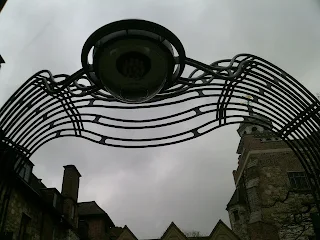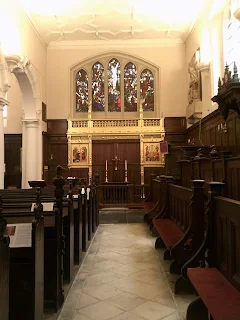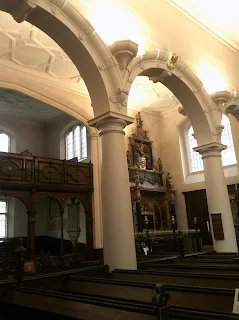The Charterhouse is an area of London known as Smithfield, to the corner of Charterhouse Square. It's in the London Borough of Islington and the nearest Tube stations are Barbican and Farringdon. To me, this is very much the heart of the city and I've always loved the way you get gleaming, modern chrome-glass buildings juxtaposed with the ancient.
I have also created a YouTube vlog, link:-
TIMELINE
* 1348- The Charterhouse has existed on this spot since this date. It takes its name from a Carthusian priory founded in 1371. Carthusian means a religious Catholic order of enclosed monastics, and is also known as the Order of Saint Bruno.
* 1537- The priory was dissolved under the orders of Henry VIII, but fragments from this period still remain.
* 1545- Rebuilt after this date as a large courtyard house.
* 1611- Site extended when it became a school and almshouse.
* 1872- The school moved to Godalming, Surrey, and this part of the building became St Bartholemew's Hospital Medical School and then its successor, Barts and The London School of Medicine and Dentistry. This section has been much developed over time.
* 1941- The building was hit by an incendiary bomb during World War II, which caused an extensive and devastating fire.
* 1958- Queen Elizabeth II opened the restored Charterhouse buildings.
The Charterhouse continues to serve as an almshouse (low cost community housing held in trust for local people in need of housing) for 40 pensioners- known as Brothers- who are in need of companionship and financial support. In recent years modern housing and a care home, for those who need respite or permanent medical help, have been added to the existing site.
From 2016, women were allowed to be admitted to these ranks and the museum opens to the public with the support of the Museum of London.
It was a drizzly day when I visited, and tried to take a few pictures of Charterhouse Square. I quite liked the little iron construction in the corner, which I nicknamed 'the summerhouse'!
To the left of the photo is Florin Court. This Art Deco building serves as the London home of Hercule Poirot- Agatha Christie's fictional detective- in the TV series, where it is named Whitehaven Mansions.
To the left of the photo is Florin Court. This Art Deco building serves as the London home of Hercule Poirot- Agatha Christie's fictional detective- in the TV series, where it is named Whitehaven Mansions.
I gave up on the umbrella I was trying to juggle and took this photo of a gnarly tree. The Charterhouse is to the left of the photo.
Spindly tree with the side of the Charterhouse building behind...
Through the central door of the last photo is a courtyard view. There were only certain parts of this extensive building that I could pop inside...
The Charterhouse, from further around the side...
The Charterhouse from the front...
The Charterhouse from the gate...
On an off-key note, I liked the way this gate reminded me of Art Nouveau...
Close-up of the featured Charterhouse model...
The Tower...
This is a floor plan of the Charterhouse. The shop, museum (just behind the Chapel Cloister) and Chapel are free to enter...
In the museum this timeline traces the role of the building throughout time...
Novelist Anthony Powell quoted this romantic opinion of the building...
Ye olde chair...
Weak (or 'small') beer was offered daily to the Brothers from the 17th century, as it was considered safer to drink than water. Their beer came from a brewery in Romford...
Museum gallery...
Old boys of the school, which include the writer William Makepeace Thackeray (1811-1863). The Charterhouse became a school in 1611, when Thomas Sutton (1532-1611), the owner of only 7 months, bequeathed money to retain a hospital (almshouse), chapel and school.
The monitor's desk, where the names of previous monitors would have been engraved into the woodwork. Monitors who were disliked would have their names scratched out by other boys! The school was originally intended to educate 40 boys but it reached above and beyond expectations to become a well-known public school. In 1872 it relocated to Goldaming, Surrey.
I took this photo of a toasting fork purely because my parents owned one like this which they used to use, as we had an open fire...
Following the dissolution of the monasteries, the house was sold to Sir Edward North in 1545. He rebuilt the buildings as a large courtyard mansion and renamed it Howard House. This is a plaster decoration above the fireplace at the end of the gallery...
A body cast in plaster was on display...
Sir Edward North 'made a banqueting hall out of a church' and both Elizabeth I and James I held court here. It occurred to me that I was going through the gallery the wrong way, and backwards in time! (Or "backwards for Christmas" as my mother would have said!) But that appears to be the way the museum is set out, and even their timeline runs backwards.
Here is a money chest from around that time...
Wall friezes...
Stained glass...
Leather bellows for the fire...
Following the Reformation there was some distinction between the Catholic Eucharist cup to the fore of the picture and the Church of England Communion cup to the rear, next to the old chunk of chapel...
These lights are in a section dedicated to the Black Death. The Black Death was a bubonic plague pandemic, and it occurred throughout Europe between 1346-1353.
The site was a burial ground from 1348.
Twenty-five skeletons were unearthed during the construction of Crossrail in Charterhouse Square in 2013. Matey here was one of them, and is a Black Death victim...
Leaving the museum and this is the memorial at the end of the Chapel Cloister...
Chapel Cloister gallery, and architecturally a cloister connects the various buildings of a monastery to the chapel by means of a covered walkway.
From the Chapel end...
...And through the door...
The front garden through the windows...
Plaque dedicated to 'old boy' William Makepeace Thackeray. He wrote Vanity Fair; one of my favourite books.
Peter Baden-Powell (1913-1962) also went to school here. He founded Scouting.
Under the Tower, and here's the font and candle holder. The Chapel is still used as a place of worship and services regularly take place here.
Taking a step back, and The Charterhouse is a Peculiar, which means it's overseen by an Ordinary, who is the Master and Chief Executive rather than the Bishop. The Preacher is appointed by the Governors.
The Chapel itself dates back to 1512; although little remains from that time.
The North Aisle of the Chapel is a 1614 addition.
Seating to the side, and this bay was completed in 1825 to accommodate the schoolboys.
Looking over to the Chapel, and it survived the turbulent Reformation of 1535 and was used to house Henry VIII's hunting equipment, tents and marquees.
Looking back down the North Aisle towards the organ, which dates from 1842.
This statue/plaque is dedicated to former Charterhouse pupil and English judge and politician Edward Law, 1st Baron Ellenborough (1750-1818).
Alumni of the school include diplomats, activists, engineers, historians, academics, business people, Members of Parliament and even royalty. They are collectively known as Old Carthusians.
Looking over to the North Aisle, and in the corner is the Thomas Sutton Memorial. Sutton (1532-1611) is interred here, and he left his fortune to establishing an almshouse for 80 impoverished gentlemen, and a school for 40 boys.
The memorial depicts a preacher giving his lesson to forty brothers of the Charterhouse. Up until 1907, Brothers had to attend the Chapel twice a day or risk being fined.
Graves on the floor...
I left the chapel and re-entered the shop. Apparently, I can only walk through this part of the garden via a tour...
The tours are £15 (£20 if you choose a Brother's tour) and take in the extensive parts of the building which are not free, like the museum and chapel are. Unfortunately, the timings and availability on this particular day did not suit me...
...There are also garden tours, but I was told that these are sold out for the rest of the year! Actually, a glimpse online reveals that this is not true. They have garden open evenings once a month in the Spring and Summer, and these cost £10 each.
Back out through the front garden...
Through Charterhouse Square...
The Charterhouse tea room is in the white building...
I'll leave you with a picture of May blossom- a bit of a contradiction since it's not yet May and it was a drizzly, wet day. Would I return? Yes, I would certainly consider an inside tour, if not the garden tour.
TTFN
The Miss Elaineous
XXXXXXXXXXXXXXXXXXXXXXXXXX
X






















































No comments:
Post a Comment